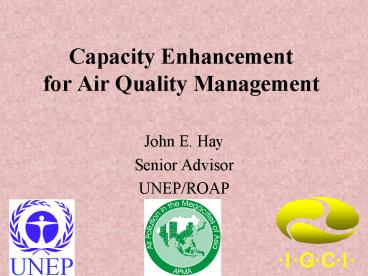Capacity Enhancement for Air Quality Management - PowerPoint PPT Presentation
1 / 19
Title:
Capacity Enhancement for Air Quality Management
Description:
Technology. Information and skills. Infrastructure. Institutions and ... Internalizing environmental costs. Cumulative impacts spatial and temporal ... – PowerPoint PPT presentation
Number of Views:44
Avg rating:3.0/5.0
Title: Capacity Enhancement for Air Quality Management
1
Capacity Enhancementfor Air Quality Management
- John E. Hay
- Senior Advisor
- UNEP/ROAP
2
Capacity Enhancement
- Alternative,
- but not identical terms
- Capacity Building
- Capability Enhancement
3
Broader Dimensions of Capacity
- Economic wealth
- Technology
- Information and skills
- Infrastructure
- Institutions and Institutional Systems
- Equity
4
Evolution of Approaches to Managing Urban Air
Quality
?
?
Sustainable Ecosystems
2000s
2000s
Problem Prevention
Problem Prevention
1990s
1990s
Problem Solving
Problem Solving
1980s
1980s
Problem Fixing
Problem Fixing
1970s
1970s
Changing Requirements For Air Quality Management
Problem
Problem
Identification
Identification
1960s
1960s
5
Strategies for AQ Management
- Land use (zoning) approach
- Regulate emissions from point sources
- Regulate emissions to achieve ambient AQ targets
- Regulate emissions to avoid unacceptable impacts
on the environment, including humans
6
Air Quality Management as
- discrete measures or actions (e.g.
- emission controls
- fuel substitution
- inspection and maintenance
- establishing standards
- raising awareness)
- the capacity to manage the air quality
- an evolving, dynamic, integrated process
7
The Air Quality Management Process
Knowledge, Methods, and Tools (e.g. monitoring,
dispersion modelling, emission inventories)
8
The Pressure-State-Response Model
9
Components of an AQ Management Plan
10
Capacity Enhancement (cont.)1. Methods and Tools
- Examples Access to
- Ambient and emissions monitoring equipment
- Inventory methodologies
- Atmospheric dispersion models and input data
- Information for setting standards/guidelines
- Information for selecting performance indicators
11
Capacity Enhancement (cont.)2. Building
Knowledge and Understanding
- Examples Strengthened ability to undertake
- Technical assessments
- Airshed carrying capacity
- Guideline exceedances
- Photochemical smog potential
- Reviews of best practices
- Assessments of air pollution technologies
12
Capacity Enhancement3. Development of Policies
and Plans
- Examples Strengthened ability to
- Assess policy options
- Ensure stakeholder communication participation
- Select most effective policy option
- Assess effectiveness of implemented policies
13
(No Transcript)
14
Capacity Enhancement4. Mainstreaming AQ
Management
- Examples Strengthened
- Mandate to manage air quality
- Institutional support
- Political support
- Integration of AQ regulations in national
environmental and development plans
15
Capacity Enhancement5. Implementation
- Examples Strengthened capabilities regarding
- Funding of implementation costs
- Expertise to support implementation
- Communication, empowerment participation of
stakeholders - Compliance and enforcement
- Monitoring
- Reporting
- Prosecuting
16
Capacity Enhancement6. Monitoring and Evaluating
Effectiveness of the AQ Management Plans
and Policies
- Examples Increased capability to
- Establish performance criteria and suitable
indicators - Monitor performance of plans and policies
- Assess performance
- Recommend responses that remedy failures and
build on successes
17
Capacity Enhancement7. Multi-partner Approaches
- Examples Increased capability to
- Identify partners and stakeholders
- Government (local, central)
- Private sector
- Civil society
- Regional and international organisations
- Financiers/Donors
- Resolve potential conflicts
- Harmonise approaches, achieving economies of
scale
18
Challenges in Air Quality Management
- Examples
- Prevention vs control
- Minimization of waste vs emission of waste
- Internalizing environmental costs
- Cumulative impacts spatial and temporal
- Recognition of interdependencies
- Central vs local management
19
Approaches
- Improved capacity to maintain or enhance air
quality in ways that are sustainable and - responsive to identified needs and values
- integrated, strategic and comprehensive
- assured of achieving the desired results
- supportive of related policies (e.g. appropriate
economic and social development) - innovative, but consistent with traditional
indigenous practices - cost effective and add value to other initiatives
- encourage complementary activities
20
Conclusions..
- AQ management
- Is an evolving, dynamic and integrated process
- Faces diverse challenges including inadequate
capacity to manage effectively - Approaches need to be sustainable, integrated,
strategic and comprehensive - Capacity enhancement is more than capacity
building - Growing number of tools, methodologies and
capacity enhancement activities - Must ensure they address the needs and
capabilities of the target groups






























